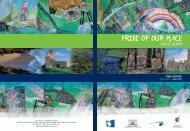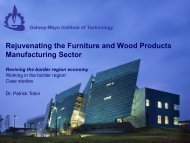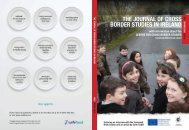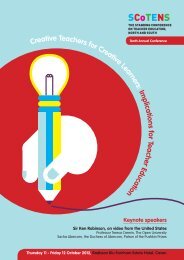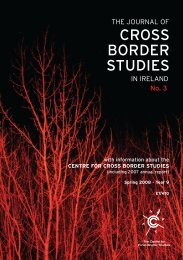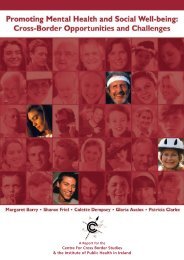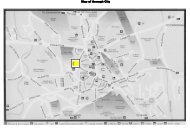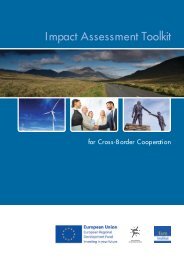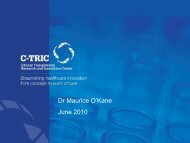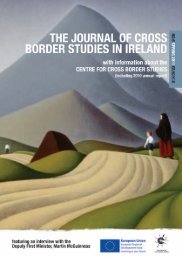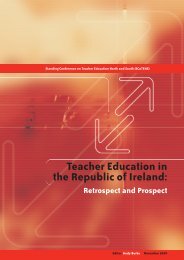improving government service delivery to minority ethnic ... - NCCRI
improving government service delivery to minority ethnic ... - NCCRI
improving government service delivery to minority ethnic ... - NCCRI
You also want an ePaper? Increase the reach of your titles
YUMPU automatically turns print PDFs into web optimized ePapers that Google loves.
Demographics<br />
Until data from the forthcoming 2006 Census is published, it will not be possible <strong>to</strong> provide a comprehensive<br />
overview of <strong>ethnic</strong> diversity in Ireland because of the lack of an <strong>ethnic</strong>ity question in the 2002 Census and<br />
because of the dramatic changes in inward migration in<strong>to</strong> Ireland since the EU expanded in May 2004.<br />
The 2002 Census of Population provides a breakdown by nationality in Ireland and identifies five main regions<br />
of origin for <strong>ethnic</strong> diversity in Ireland. These are the UK and other EU nationals (3.4% of the <strong>to</strong>tal population),<br />
Asian (0.5%), African (0.5%) non EU Europeans (0.5%) and the United States (0.3%). The Census also<br />
identified that the Traveller population in Ireland was around 24,000, representing 0.6% of the population of<br />
Ireland, although NGOs feel that the true figure is closer <strong>to</strong> 30,000. 200 The Central Statistics Office will be<br />
introducing an <strong>ethnic</strong>ity question in<strong>to</strong> the 2006 Census for the first time, which will give a much fuller picture of<br />
<strong>ethnic</strong> and related forms of diversity in Ireland.<br />
Ireland has gone through a period of major social change in the past twenty years. Several significant changes<br />
have occurred in the areas of demography and migration:<br />
-<br />
-<br />
Ireland’s emigration rate, which had fallen in the 1960s, reversed in the 1970s and peaked anew in the<br />
1980s, has now fallen <strong>to</strong> a his<strong>to</strong>rically low rate of less than 17,000 per annum. Most modern-day emigrants<br />
are voluntary and the evidence of the 1980s suggests that at least half will return. For both demographic<br />
and economic reasons, it is reasonably safe <strong>to</strong> say that a return <strong>to</strong> mass emigration levels comparable <strong>to</strong><br />
those of the 1950s and 1980s is unlikely.<br />
The demographic transition observed in other European countries arrived probably thirty years later in<br />
Ireland than in other places. Total fertility rates (TFR) in Ireland in the 1960s were, at more than 4.0, more<br />
than twice the average figure at the time elsewhere in northern Europe. From the 1980s onward a pattern<br />
of convergence <strong>to</strong>ward the European norm was clearly visible. Today the Irish TFR is still, at 1.98, the<br />
highest in the EU and contrasts sharply with that of Italy and a number of other Member States, including<br />
some of the new Accession States, where the TFR is well below the replacement rate. But Ireland’s<br />
demographic structure has changed for good and it is likely that the country will experience, albeit at a<br />
different pace, the same phenomena of an ageing population, diminishing young indigenous population and<br />
a rising immigration rate that can be noted in virtually every other wealthy European country.<br />
200_Pavee Point Travellers<br />
Centre (2005), Irish<br />
Travellers Shadow Report<br />
<strong>to</strong> the Committee on<br />
the Elimination of Racial<br />
Discrimination, p.18.<br />
201_European Economic<br />
Area: EU states and<br />
Norway, Iceland and<br />
Liechtenstein. A separate<br />
but similar regime operates<br />
with Switzerland.<br />
202_There are certain<br />
exceptions such as<br />
students, persons married<br />
<strong>to</strong> EU citizens and persons<br />
with refugee status or leave<br />
<strong>to</strong> remain.<br />
203_Department of<br />
Enterprise, Trade and<br />
Employment<br />
http://www.entemp.ie/<br />
labour/workpermits/<br />
statistics.htm#byyear<br />
EU Migrants and Non-EEA Work Permit Holders<br />
In common with asylum seekers and refugees, the number of people moving <strong>to</strong> Ireland <strong>to</strong> seek work has<br />
increased dramatically. Non-EEA 201 citizens require work permits <strong>to</strong> work in Ireland. 202 These permits are issued<br />
through two different mechanisms: the Working Visa/Work Authorisation (WV/WA) programme and the Work<br />
Permits scheme. These schemes, while complementary, cater for people from different places with differing<br />
skills. The WV/WA programme targets high skilled, well educated workers needed for the <strong>service</strong> and highskilled<br />
manufacturing sec<strong>to</strong>rs. The Work Permits scheme targeted lower skilled workers, from outside the<br />
EEA, needed for catering, agriculture, industry, nursing, and domestic home help. Prior <strong>to</strong> 1998 work permit<br />
applications were below 5,000 per year, from then on numbers of applicants rose steadily until 2003, peaking<br />
that year at 47,551. 203



